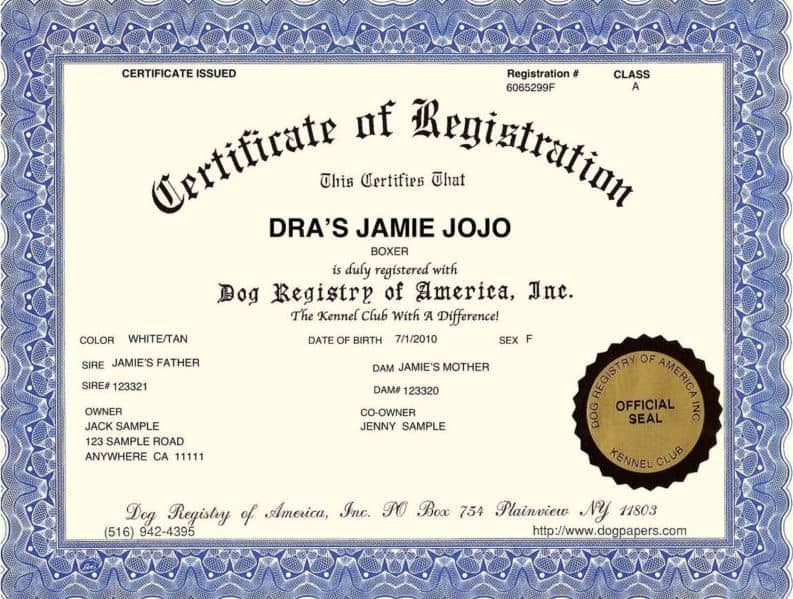Dogs make great friends, thanks to their undying loyalty and compassion. They are essentially better version of ourselves.
You can trust your pooch not to judge you, hold on to past mistakes, or love you based on anything. Instead, they will love you to the end and protect you at all costs.
Naturally, you want to try your best to reciprocate this love and devotion.
In addition to providing your pup with the basic needs, getting it registered is also part of responsible pet parenting.
Not only do you gain access to valuable information about the wellbeing of your dog but you open up a world of possibilities for him as well. He can participate in dog shows and competitions.
If you are in the United States and want to register your dog for the very first time, it can be confusing to know what to do.
For one, there are many registries to consider. Choosing one can be a real challenge.
Additionally, filling out the actual paperwork is not easy either. So, how do you register a dog for the first time?
1. Choose A Registry

With tens of recognized dog registries in the United States alone, knowing where to register your pup can be a nightmare.
The fact is that each registry offers certain benefits for your doggie. Some enter him on dog shows while others offer sporting event opportunities. There are those that have protection services for your beloved pet as well.
Before you make your choice, it’s a great idea to go through each registry and determine what you want to get for your sweet dog.
The three most popular kennel groups include the American Kennel Club (AKC), the United Kennel Club (UKC), and the Continental Kennel Club (CKC).
These three are known nationwide and offer great advantages for pet owners.
For people with service dogs, there are a ton of service dog registries to consider as well.
If your doggie is of a rare breed that is not recognized in common registries, you have alternative options on the table.
Finally, you can also register your dog with a breed-specific registry if you wish. Take your time and find out what suits your needs and those of your dog the best.
While you are at it, keep in mind that not all dog registries are beneficial. While there are many great ones, there are equally bad ones that you need to avoid.
Stay away from registries that have a simple registration process. These will only ask you for the photo of your dog as the only proof that he is purebred.
Others ask for large sums of money because they are in the business and don’t care for animals at all.
Also, if you come across a registry without a solid code of ethics to be followed, take a walk.
2. Register The Dog

Once you have nailed your registry (ies) of choice, your next step is to get your dog registered with them.
Different dog registries have different application requirements.
Some will ask you for a lot of information including three-generation registration certificates of the dog. This will mean going back to the breeder if you don’t have these documents. The United Kennel Club (UKC) is known for this.
Before you get your papers, you need the certificates of three generations of the dog all the way to the grandsire and the grand dam.
The AKC is keen on the registration of the pooch from the breeder that sold you the pup. If you are looking to register a service dog, you may need to proof your disability to the registry.
However, most kennel groups require basic information such as the name of the dog, its photos (from different angles), breed, sex, and date of birth), your contact information, and payment method. (Please note that this payment is non-refundable).
Finally, some registries allow for online form submissions while others are old-school and need you to mail the forms or visit their brick-and-mortar locations.
Before you fill out any information, gather the following:
- The breed of your dog (including any specifics where applicable)
- A photo or scan of the vet certificate showing that your dog has been altered.
- If your pooch has been microchipped, keep the microchip number and a scan/digital photo of the microchip certificate.
- Pedigree certificates of the dog where applicable: Your breeder should be able to supply you with this.
- Photos of your pooch: You will be required to attach the front of the dog, the back, and the side. Get clear photos that are easy to decipher.
- Payment information: Card holder’s name, number, expiry date, etc.
- Contact information: Your home address, email address, mobile number, city, and state.
3. Fill out The Forms And Wait

With the information duly included in the application form, your next step is to submit the forms.
You may do that online or via mail depending on the requirement of your registry.
If you are following the former route, payment is often via Mastercard or Visa.
Once the payment has been received, the registry will review your application.
If you pass, you will be notified within a specified time. This time varies for different registries.
For instance, the AKC’s responds within around three weeks after submission of the filled forms.
Others take as little as ten days to process your information and tell you if your dog has been registered or not.
If you don’t get any information within the promised time, contact the registry and find out what’s taking so long.
Related Post: How to Fill Out UKC Registration Papers
4. Confirm the Details Of The Certificate

The last step in registering your dog for the first time is to make sure that the certificate bears the right information.
After the registry reviews your submission and sends back the certificate, go through it carefully.
Although it doesn’t happen often, it is possible for the registry to get some of the information mixed up.
If you notice any errors, make contact with the registry as early as possible.
Only keep the certificate when it contains the right information.
Closing Thoughts
The process of registering a dog is somewhat of a challenge even for experienced pet parents.
First, you have to determine where you want the dog registered. Don’t rush the process if you want to get nothing but the best for your doggie.
Once that is out of the way, you have to do the actual registration – fill the forms with detailed information as required by the registry in question.
After mailing the forms back to the registry, now wait for their feedback.
Finally, confirm that everything is correct in the certificate.
It seems tedious and time-consuming but for the love of your pooch, it is the least you can do.
Related Posts:
How To Register A Dog With AKC Without Papers
As an Amazon Associate, we may receive a small commission from qualifying purchases but at no extra cost to you. Learn more. Amazon and the Amazon logo are trademarks of Amazon.com, Inc, or its affiliates.

